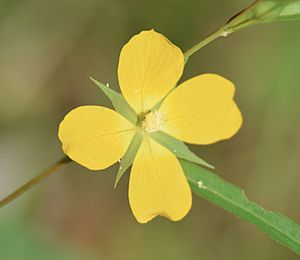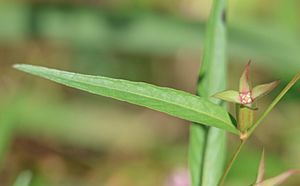Willow primrose facts for kids
Quick facts for kids Willow primrose |
|
|---|---|
 |
|
| Flowers have four to five yellow petals. | |
 |
|
| Alternately arranged linear leaves. | |
| Conservation status | |
| Scientific classification | |
| Genus: |
Ludwigia (plant)
|
| Species: |
decurrens
|
Ludwigia decurrens, also known as the willow primrose or wingleaf primrose-willow, is a type of flowering plant. It belongs to the evening primrose family. This plant is originally from the central and eastern parts of the United States. It often grows in wet areas.
Contents
What Does the Willow Primrose Look Like?
The willow primrose can be an annual or a woody perennial plant. This means it can either live for one year or come back year after year. It can grow quite tall, sometimes up to 6 feet (about 1.8 meters).
Stems and Leaves
This plant has a straight, upright stem. The stem is special because it has "wings," which are flat, thin parts running along its length. Its leaves are long and narrow, shaped like lines. They are arranged one after another along the stem.
Flowers
The flowers of the willow primrose are bright yellow. Each flower usually has four or five petals. These pretty yellow flowers add a splash of color to the wet places where the plant grows.
Where Does the Willow Primrose Grow?
The willow primrose loves wet places. You can often find it growing in swamps, marshes, ditches, and along the edges of ponds or streams. It likes habitats where the soil stays moist or even flooded for parts of the year.
Plant Neighbors
In these wet areas, the willow primrose often grows alongside other plants. For example, it can be found near species from the Polygonum family (like knotweeds) and Cyperus family (like sedges). These plants all share a love for damp environments.
How Does Willow Primrose Interact with Other Plants?
The willow primrose has a special ability called allelopathy. This means it can produce natural chemicals that affect other plants around it. These chemicals can sometimes stop other plants from growing well.
Plant Superpowers
Think of it like a plant's way of competing for space and resources. By releasing these chemicals into the soil, the willow primrose can make it harder for other plants to thrive nearby. This helps the willow primrose get more sunlight, water, and nutrients for itself. It's a clever strategy for survival in its habitat!


